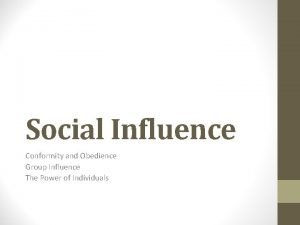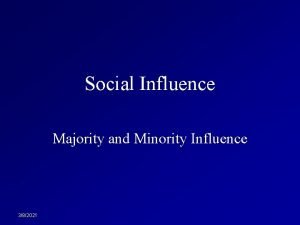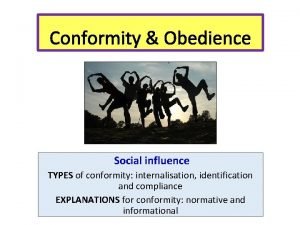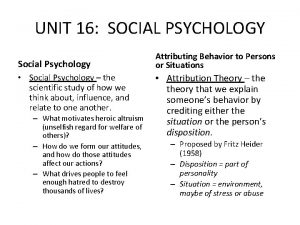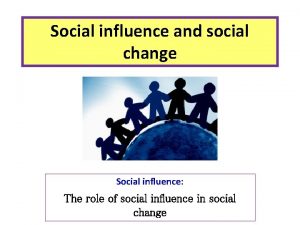Social Psychology Lecture 3 Social Influence Chapter 7





















- Slides: 21

Social Psychology Lecture 3: Social Influence (Chapter 7; Hogg & Vaughan)

At the end of the lecture. . . • General Question: Ways that ideas of social influence are conceptualised within Social Psychology’ • • • Types of social influence Obedience to authority Conformity Processes Minority Influences

There are many different sources of power that people can access to persuade others Figure 7. 1 Source: Based on Raven (1965)

Types of social influence • Social influence takes different forms. • Compliance refers to a situation in which you do what someone asks you to do, or you go along publicly with a request, but you do not necessarily change your underlying attitudes and feelings. • Obedience is one form of compliance: You do what someone tells you because he or she is in a position of power over you. (This person has the power to reward and punish you. ) • Membership groups — groups you are in by some external designation only — produce compliance. • In contrast to compliance is conformity. You internalize a group norm as being relevant to who you are. Influence creates genuine, internalized attitude change. • Reference groups (groups you feel you belong to) produce conformity.

Obedience to authority Blind obedience to authority can cause people to do terrible things they would never do on their own. Obedience to authority is often the mitigating plea made by people charged with crimes against humanity. In his classic obedience study, Stanley Milgram found that very ordinary people would ostensibly administer a massive and deadly electric shock to a stranger who merely got word pairs wrong, simply because the experimenter ordered them to do so. A major surprise was that this willingness to shock far exceeded expectations. Milgram's research stirred up a fierce debate in psychology concerning the ethics of doing research and has led to the development of very stringent guidelines for psychological research.

Predicted versus actual levels of shock given to a victim in Milgram’s obedience-to-authority experiment Figure 7. 3 Source: Based on data from Milgram (1974)

Conformity • Conformity is a process of internalized cognitive change as the consequence of influence, largely by group norms. • Group norms obey the metacontrast principle: They capture similarities with a group and differences between groups. Norms arise to regulate behaviour; we use people’s relevant behaviour as a frame of reference to determine the norm. • Experiments in which a single person would take part surrounded by a group of confederates of the experiment • Sherif showed this in a series of studies where people estimated the movement of a light source in a dark room (autokinesis); over time the estimates converged on the average of the group, and this norm persisted to influence new members of the group.

Figure 7. 4 Experimental induction of a group norm Source: Based on data from Sherif (1936)

Conformity • Norms are powerful. Asch showed that people find it extraordinarily difficult to resist being influenced by an incorrect majority if that majority is consistent and unanimous - even one dissenter can dramatically reduce the majority's power over the individual. • Experiments in which a single person would take part surrounded by a group of confederates of the experiment

Conformity • Situational factors account for considerable variance in the tendency to conform. • Conformity to group pressure is much higher when the majority is unanimous. It is also higher when the size of the group increases, though its at full strength when you have a three to five majority (Stang, 1976). • Group size may have a different effect depending on what type of judgement is being made and the motivation of the person. E. g. if you are concerned about being correct then you may be swayed with less people (Campbell & Fairey, 1989). • Support also a situational factor

Conformity as a function of presence or absence of support, and of competence of supporter Figure 7. 8 Source: Based on data from Allen & Levine (1971)

Conformity Processes • Conformity occurs via three possible processes • informational influence • normative influence – dual-process dependency model • referent informational influence – Challenge to the dual-process dependency model

Conformity Processes • informational influence: Accept information from others as evidence about reality. • People need to feel confident that the perception, beliefs and feeling are correct. Informational influence comes into being when people are uncertain, because either the stimuli is ambiguous or there is social disagreement. • Linked to Sherif’s findings

Conformity Processes • normative influence: You may conform to gain approval and avoid censure from others • People have a need for social approval and acceptance, therefore this explains why people go along with the group. • normative influence becomes important when the group is perceived to have power, by being able to provide rewards, or punishment (via social disapproval). • Link to Asch’s findings.

Conformity Processes • normative influence: Accept information from others as evidence about reality • informational influence: conform to gain approval and avoid censure from others • together these processes represent a dualprocess dependency model of influence.

Conformity processes • The third process, based on the social identity approach, is referent informational influence: You conform because norms defines the membership in a group that is an important aspect of your self-concept. • Dual Process model focuses on interpersonal dependency, while this emphasises the social groups that you belong to and group norms. • Therefore you don’t conform to others you conform to what is expected from your group norm.

Conformity processes • Dual Process model example • If you were in a meeting with a lot of university students and they were discussing something that disadvantaged students in psychology, you wouldn’t necessarily conform to that discussion, you probably would conform to what the group norm is for psychology students and object. • Equally if you were in a discussion with psychology students regarding the same aspects but this time the intended action disadvantaged economic students you may not object to this

Minority influence • Social Change suggests minority influence • Suffragettes of the 1920’s changed public opinion that women got the public vote • Nelson Mandela in South Africa • Greenpeace has slowly helped changed our attitudes to the environment • Moscovici and Faucheux (1972) have pondered whether Asch and Sherif observed in their classic experiments evidence of majority influence but the extent of minority influence • Moscovici has argued that there are three social influence modalities in the occurrence of social conflict • Conformity: majority influence • Normalisation: Mutual compromise leading to convergence • Innovation: minority creates and accentuates conflict to accept minority viewpoint

Minority influence • Moscovici developed the genetic model of minority influence • Whether a minority can win over a majority depends on how the minority goes about its task (its behavioural style) • The single most important behavioural style is consistency – all the members repeat the same message • This leads to • Disrupts the majority norm and provides uncertainty • Draws attention to itself as an entity • Conveys the existence of a alternative and coherent point of view • Demonstrate certainty in, and unshakable commitment to, its point of view • It shows that the only solution to the conflict that has arisen is the adoption of the minority viewpoint

Revision Hints • When reading about studies each is quite different in the method it uses. It might be wise not to get bogged down in the methods, but look for common ground in terms of the arguments being put forward • Lot of material in this topic, and you won’t be able to cover every topic. Therefore be selective and concentrate on the main ideas.

At the end of the lecture. . . • General Question: Ways that ideas of social influence are conceptualised within Social Psychology’ • • • Types of social influence Obedience to authority Conformity Processes Minority Influences
 Social thinking and social influence
Social thinking and social influence Social thinking social influence social relations
Social thinking social influence social relations Social thinking social influence social relations
Social thinking social influence social relations Informational social influence
Informational social influence Informational social influence example
Informational social influence example What is informational social influence in psychology
What is informational social influence in psychology Superordinate goals
Superordinate goals Social behavior psychology definition
Social behavior psychology definition Social psychology lecture
Social psychology lecture 01:640:244 lecture notes - lecture 15: plat, idah, farad
01:640:244 lecture notes - lecture 15: plat, idah, farad Social thinking and attribution theory
Social thinking and attribution theory Social psychology ap psychology
Social psychology ap psychology Social psychology is the scientific study of
Social psychology is the scientific study of Forensic psychology lecture
Forensic psychology lecture Introduction to psychology lecture
Introduction to psychology lecture What is health psychology
What is health psychology Conversion social influence example
Conversion social influence example Examples of informational social influence
Examples of informational social influence Values and norms examples
Values and norms examples Passivity
Passivity Maypole interaction pattern
Maypole interaction pattern Internalisation conformity
Internalisation conformity




